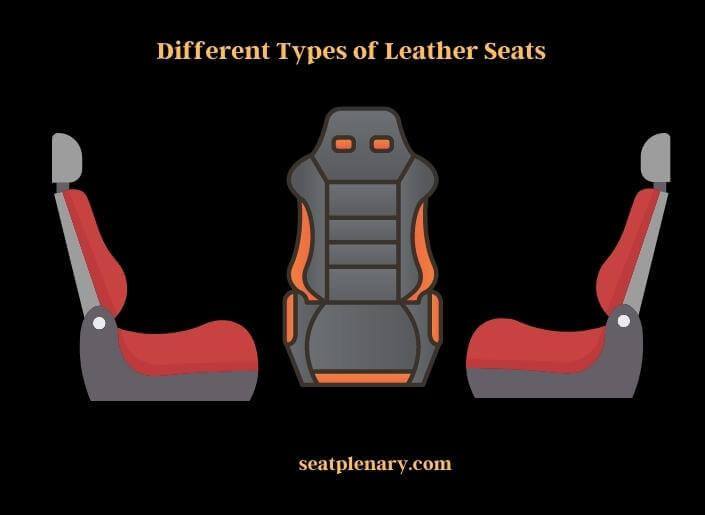Car seats are an essential component of any car, as they provide comfort and support while driving. The material used to make car seats can significantly impact their overall quality and durability. Leather seats are an excellent option for car owners due to their many advantages, including durability, comfort, and appearance.

The durability of leather seats is unmatched, as high-quality leather can withstand years of use without showing any signs of wear and tear. Additionally, leather seats are incredibly comfortable due to their ability to conform to the body and regulate temperature. Leather seats also provide a luxurious appearance that can add value to any car.
Despite the initial cost of leather seats, they are a smart investment for car owners in the long run, as they require less maintenance and last longer than other materials. In this blog post, we will explore the many benefits of leather seats and why they are an excellent choice for anyone in the market for new car seats.
Different Types of Leather Seats
Leather seats are a luxurious and stylish addition to any vehicle or furniture piece. However, there are several different types of leather that can be used to make seats, each with its own unique characteristics and advantages. Here are some of the most common types of leather seats:
Full-Grain Leather
This is the highest quality leather available and is made from the top layer of animal hide. It is strong, and durable, and develops a patina over time that gives it a rich, attractive look.

Top-Grain Leather
This is also made from the top layer of the hide but is sanded down to remove any imperfections. It is not as strong as full-grain leather but is still high-quality and commonly used in luxury cars and furniture.
Aniline Leather
This is a type of full-grain leather that is treated with dye but no pigment, allowing the natural texture and markings of the hide to show through. It is soft and comfortable, but also prone to staining and fading.
Semi-Aniline Leather
This is similar to aniline leather but has a small amount of pigment added to it to give it more durability and resistance to staining.
Nubuck Leather
This is a type of top-grain leather that has been buffed to create a suede-like texture. It is soft and comfortable but also more delicate and prone to staining than other types of leather.
Bonded Leather
This is not true leather but rather a composite material made from scraps of leather that are glued together and coated with a layer of polyurethane. It is less expensive than real leather but also less durable and prone to peeling and cracking over time.
The durability of Leather Seats
One of the most significant advantages of leather seats is their durability. Leather is a high-quality material that can withstand years of use without showing any signs of wear and tear. Leather seats are made from animal hide, which has been tanned to create a durable and flexible material. The thickness of the leather used in car seats can vary, but most are between 1.2 and 1.4 millimeters thick, making them strong and resistant to tearing.
Compared to other materials used in car seats, such as cloth or vinyl, leather seats are much more durable. Cloth seats are susceptible to staining, fading, and wearing down over time, while vinyl seats can crack and split. Leather seats are also more resistant to spills and stains, making them easier to clean and maintain.
Proper maintenance can help prolong the life of leather seats even further. Simple actions such as cleaning and conditioning the leather regularly, avoiding exposure to direct sunlight and extreme temperatures, and using seat covers to protect them from spills and wear can make leather seats last for many years.
Leather seats are an excellent choice for car owners who want a durable and long-lasting option that can withstand years of use without showing any signs of wear and tear. The initial cost may be higher than other materials, but the long-term benefits of durability make it a wise investment.
The comfort of Leather Seats
Leather seats are also known for their exceptional comfort. Leather seats are made from natural materials that are soft and supple, allowing them to conform to the shape of your body. This feature makes leather seats more comfortable than other materials, such as cloth or vinyl.
Leather can absorb heat in the summer and feel cool to the touch, making it a comfortable option on hot days. In the winter, leather seats can retain heat, making them a cozy choice for colder climates.
Leather seats also provide a more luxurious feel than other materials, which can enhance the overall driving experience. The smooth and soft texture of leather seats adds a sense of sophistication to any car, making it a popular choice among car enthusiasts.
Although the initial cost of leather seats may be higher than other materials, their comfort and durability make them a smart investment for car owners who spend a lot of time on the road. The soft and supple texture of leather seats can help prevent discomfort or pain caused by sitting in the car for long periods, making them an excellent choice for anyone who values comfort while driving.
The appearance of Leather Seats
Leather seats are known for their luxurious appearance, which can add value and style to any car. Leather is a natural material that looks and feels expensive, giving the car’s interior a refined and sophisticated look.
Leather seats come in a variety of colors and textures, allowing car owners to customize their car’s interior to their liking. Leather seats can be made in classic colors like black, brown, and tan, or in bold and vibrant shades like red or blue. The textures of leather seats can also vary, with some being smooth and glossy while others are more textured and matte.
Leather seats are also easier to clean and maintain than other materials, such as cloth or vinyl. Spills and stains can be wiped away quickly and easily, and leather seats are less likely to develop odors or discoloration over time.
The appearance of leather seats can enhance the overall value and aesthetic of any car. The luxurious look and feel of leather seats can add a sense of sophistication and elegance to the car’s interior, making it a popular choice for car enthusiasts who want to elevate their driving experience.
Cost of Leather Seats
While leather seats offer many advantages, they can be more expensive than other materials. The initial cost of leather seats is higher than other options, such as cloth or vinyl, due to the higher quality of materials and the manufacturing process involved.
The long-term benefits of leather seats may outweigh the initial cost. Leather seats are more durable than other materials, which means they can last longer and require less maintenance over time. This can save car owners money in the long run, as they won’t need to replace their seats as frequently as they would with other materials.
Leather seats can add value to a car, making it a smart investment for those who plan to resell their vehicle in the future. Cars with leather seats generally have a higher resale value than those with cloth seats, which can offset the initial cost of purchasing them.
It’s important to note that not all leather seats are created equal, and the cost can vary depending on the quality of materials and manufacturing. High-quality leather seats made from premium materials may cost more than lower-quality options.
Maintenance of Leather Seats
Proper maintenance is essential for keeping leather seats in good condition and prolonging their lifespan. Here are some tips for maintaining leather seats:
Clean Spills Immediately
Leather seats are susceptible to staining, so it’s essential to clean spills as soon as possible. Use a damp cloth to wipe away spills and avoid using harsh chemicals that can damage the leather.
Vacuum Regularly
Regular vacuuming can help prevent dirt and debris from accumulating on the leather seats, which can cause scratches and wear over time.
Condition the Leather
Leather seats can dry out and crack over time, especially if they are exposed to sunlight and extreme temperatures. Conditioning the leather regularly can help keep it supple and prevent cracking.
Avoid Direct Sunlight
Direct sunlight can cause the leather to fade and dry out, which can lead to cracking and peeling. Park in shaded areas or use window shades to protect the leather from sunlight.
Use a Leather Protectant
A leather protectant can help repel spills and stains, making it easier to clean the seats. Make sure to choose a protectant that is suitable for the type of leather used in your seats.
Use Seat Covers
Seat covers can protect leather seats from spills, wear, and tear, especially if you have children or pets.
Conclusion
Leather seats offer many benefits that make them a popular choice among car owners. Their durability, comfort, appearance, and added value are just some of the advantages that make leather seats a worthwhile investment.
The initial cost of leather seats may be higher than other materials, their long-term benefits and ability to last for many years make them a smart investment. Proper maintenance, such as cleaning and conditioning the leather regularly, avoiding exposure to direct sunlight and extreme temperatures, and using seat covers to protect them from spills and wear, can help prolong the life of leather seats even further.
When it comes to choosing the right material for car seats, it’s important to consider your personal preferences and needs. Leather seats are an excellent choice for those who value comfort, durability, and luxury, but it’s important to weigh the cost against the benefits and decide if they are the right choice for you.
Relevant Resources:
